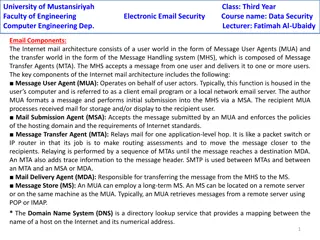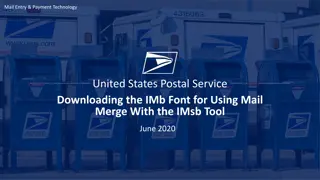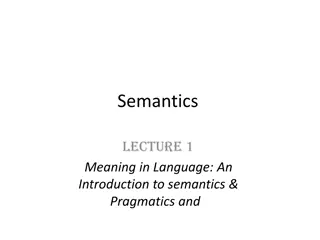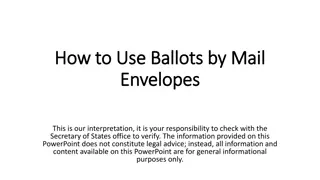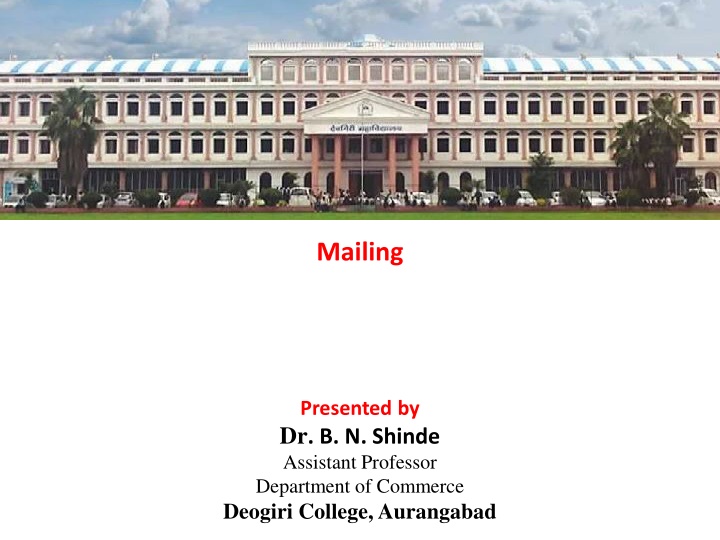
Evolution of Mail Services: From Ancient India to Modern Postal Systems
Explore the historical significance and development of mail services, from ancient Indian courier systems to the establishment of modern postal services. Discover the importance of mailing letters and how it has evolved over time, reflecting on the emotional value of receiving a physical letter in today's digital age.
Download Presentation

Please find below an Image/Link to download the presentation.
The content on the website is provided AS IS for your information and personal use only. It may not be sold, licensed, or shared on other websites without obtaining consent from the author. If you encounter any issues during the download, it is possible that the publisher has removed the file from their server.
You are allowed to download the files provided on this website for personal or commercial use, subject to the condition that they are used lawfully. All files are the property of their respective owners.
The content on the website is provided AS IS for your information and personal use only. It may not be sold, licensed, or shared on other websites without obtaining consent from the author.
E N D
Presentation Transcript
Mailing Presented by Dr. B. N. Shinde Assistant Professor Department of Commerce Deogiri College, Aurangabad
Meaning of mail The transporting postcards, letters, and parcels. A postal service can be private or public, though many governments place restrictions on private systems. Since the mid-19th century, national postal systems have generally been established as a government monopoly, with a fee on the article prepaid. Proof of payment is usually in the form of an adhesive postage stamp, but a postage meter is also used for bulk mailing. Postal authorities often have functions aside from transporting letters. In some countries, a postal, telegraph and telephone (PTT) service oversees the postal system, in addition to telephone and telegraph systems. Some countries' postal systems allow for savings accounts and handle applications for passports. The Universal Postal Union (UPU), established in 1874, includes 192 member countries and sets the rules for international mail exchanges. mail or post is a system for physically
History of mail in India The economic growth and political stability under the Mauryan empire (322 185 BCE) stimulated sustained development of civil infrastructure in ancient India. The Mauryans developed early Indian mail service as well as public wells, rest houses, and other facilities for the public. Common chariots called Dagana were sometimes used as mail chariots in ancient India. Couriers were used militarily by kings and local rulers to deliver information through runners and other carriers. The postmaster, the head of the intelligence service, was responsible for ensuring the maintenance of the courier system. Couriers were also used to deliver personal letters. In South India, the Wodeyar dynasty (1399 1947) of the Kingdom of Mysore used mail service for espionage purposes thereby acquiring knowledge related to matters that took place at great distances.
Continue By the end of the 18th century, a postal system in India was in operation. Later this system underwent complete modernization Raj established its control over most of India. The Post Office Act XVII of 1837 provided that the Governor- General of India in Council had the exclusive right of conveying letters by post for hire within the territories of the East India Company. The mails were available to certain officials without charge, which became a controversial privilege as the years passed. On this basis the Indian Post Office was established on October 1, 1837. when the British
Importance of mail The simple act of posting and receiving a letter is, in a small way, essential for our humanity and emotional well-being. Following are the some points which highlights the reasons why mailing letters is so important. 1. Feeling of Excitement Remember in the olden days , which isn t that long ago, how excited you would be when there was a letter waiting for you in the mail? Most people have that feeling now when they ve ordered something silly on Amazon (or at least the countless memes of dogs looking wistfully out of window seem to suggest this). In a world with fewer and fewer simple joys, the arrival of a letter in your mailbox is golden. And it s even better when it s an unexpected but pleasant surprise.
2. A Sense of Belonging Letters and cards that are sent through the mail are a surefire way of telling someone Hey,I ve been thinking of you. It s more than just a quick check-in text. A letter shows that you really took the time to consider the person and created something special just for them. Connect with your grandparents, university friends or your old neighbors. Everyone loves getting a letter in their mailbox and it establishes a feeling of belonging. Knowing that someone out there cares about you and that you care for them is a warm, fuzzy feeling that you can t get from an Amazon shipment or a WhatsApp text.
Continue.. 3. Documenting our Humanity Writings and drawings have documented the history of humanity for ages. The written word written on a piece of paper is incredibly personal and intimate. We get a glimpse into a person s psyche through their penmanship. How they curve the letters, how far they slant them. Whether writing on a piece of paper was intentional or spontaneous, the resulting product reveals the human behind it. Your choice of writing utensil, surface and the actual words you use speaks volumes about who you are. In contrast, the act of broadcasting your every move and meal on Twitter is more of an indication of who you want to be or who you present to be. But as projects like Found Magazine confirm, things that have been written on an old post-it or on a diner napkin or on a Wrigley s gum wrapper show the real human. Their hidden depths, their fears and hopes and the uncurated, unpolished personality traits, unique traits that are usually quashed in order to conform with the digital norm. In a way, then, the act of writing real letters or postcards and sending it via the mail is a contribution to our history. It s tangible. It has weight. It s not fleeting and superficial like a digital communication.
Continue.. 4. Wonder & Amazement Did you know you can send a banana through the mail? Of course some of the things you can send through the mail are absolutely ridiculous and most likely only allowed to instill a sense of spectacle around the whole institution. However, in some bizarre way this is a testament to the USPS s gameness, their dedication and their willingness to go the extra mile (often literally) to deliver something (besides the fact that they are legally obliged to do so).
Continue.. 5. A Kind of Fail Safe Imagine a digital collapse from one day to the next, everything disappears. Maybe this could never happen, but just imagine it for a second. If that s too drastic, just think of those moments where you actually didn t have wifi or there was some kind of malfunction when you wanted to digitally submit your term paper. Or your signed lease. Or an important email bounced back. These moments might be rare nowadays, but it is comforting to know that there is a failsafe, a backup generator of communication called the mail. So, Buy stamps, write letters and send them.
Centralization of mail handling work One of the best ways to minimize risk to your employees and the public, reduce costs, and increase the efficiency and effectiveness of your mail center is to centralize mail handling at a separate location from the rest of your organization. Having a separate mail location reduces risk by limiting exposure to potentially dangerous mail to one location and fewer people. It also reduces costs by eliminating redundancies in locations, Establishing a trained staff to work at a single location also increases the efficiency of your operations. staff, and equipment.
Continue.. Advantages of centralized mailing service The main object of centralized mail service is to handle the mail efficiently and economically. The following advantages have been derived from the centralization of mailing service. 1. The mailing department or section is responsible for handling of mail i.e. inward, outward and inter- departmental. 2. There is a systematic handling of mail service. 3. Functional departments are relieved from the work of mail handling. 4. It reduces the duplication of work and errors also.
Continue.. 5. Efficient, accurate and speed in mail service is available through the specialization in mail service. 6. An expert and qualified supervisor can appointed to allocate the work. He can evenly distributive entire work among the available personnel and effectively supervise their work without break. 7. There is a better co-ordination of the work in the mailing department. 8. There is a savings in time and money due to specialization, coordination, no error in work etc.
Continue.. 9. Prompt and careful opening of inward mail, careful scrutiny of the envelop and their enclosure, accurate stamping of date and time of receipt and prompt distribution of the mail to proper departments and persons are ensured. 10. Mechanization of the mail service possible at the maximum. 11. Careful folding and insertion in to envelops of the outward mail, proper sealing and stamping of the envelopes, accurate recording in the dispatch register and prompt dispatch or delivery of the mail are also ensured. 12. There is a proper routing of unopened mail of a confidential nature to the proper addressee.
Continue.. 13. There is a best control on the utilization of postage stamps. In other words over stamping, under stamping and / or non-stamping are avoided. 14. The special arrangement with post office is very easy. 15. Labour saving devices such as letter opening, folding and sealing machines can be used economically. 16. This procedure gives best training to new employee in the routine of the office.
Mailing through post The primary function of Post Office is collection, processing, transmission and delivery of mail. All postal articles whose contents are in the nature of message can be classified as mail which includes Letters, Postcards, Inland Letter Cards, Packets, Ordinary, Registered, Insured, Value Payable articles and Speed Post. Mail is further classified as first class and second class mail. First class mail gets free air transmission within India; whereas second class mail gets air lift only if prepaid with air surcharge.
What is courier A courier service is a company, usually a private firm, that facilitates the shipping of parcels and important documents. Courier services can either specialize in a specific type of shipping within certain destinations (for example, same-day local shipping or regional shipping) or cover an array of shipping services with destinations worldwide.
Types of courier services Time-sensitive shipping: There are courier services that aim to deliver goods worldwide within specific time frames (such as 1-3 business days) and within specific hours during the day (for example, 8-10 AM). DHL Shipping and FedEx courier services are examples of courier companies with these goals.
Continue Local shipping: Some courier services focus on providing speedy, same-day delivery for parcels and important documents within the limits of a major metropolitan city. An example of this is Breakaway Courier in New York City.
Continue International shipping: You can also find courier services with overseas networks that can help you ship your goods to foreign destinations. They may also include services such as frequent tracking or tax and duty handling at an extra cost to ensure your shipment has reliable transportation and can pass through customs without any issues. China EMS, DTDC, and Aramex are couriers that fit this example.
Email- Definition Electronic mail (email or e-mail) is a method of exchanging messages ("mail") between people using electronic devices. a means or system for transmitting messages electronically (as between computers on a network)communicating by e-mail Messages sent and received electronically through an e-mail system receives a lot of e- mail
Email There are four parts for an email address which include the username, an @ symbol, domain name, a dot, and the domain. Let us know what these are. Username: This part is usually the name of the person to whom the mail is sent. (name@outlook.com) @ symbol: This separates the username and domain name. The symbol @ was invented by Ray Thomilson in 1971. (name@yahoo.com) Domain name: This refers to the mail server, the place where your email is stored. (name@outlook.com) A dot (.): This separates part of the address. The domain: Domain tells what type of web page you are using (.com,.org,.edu, etc ). Eg: (name@outlook.in)
What is office automation? Technology has made a serious impact on the daily work of office administration. Emails have replaced memos and biometrics have taken over employee timesheet stamping. Many businesses think that they have attained office automation nirvana simply by going paperless. Office automation is the process of watching data flow around on its own without any human intervention, inaccuracies, and errors. It is the process of using an automation tool to create, collect, store, analyze, and share confidential office data that is required to accomplish basis day-to-day routine tasks and processes effectively. But office automation is a different ballgame altogether. Using online forms and sending Google Calendar invites might mean that you ve ditched a lot of paper, but it doesn t mean you are automated. It just means that instead of pushing around the paper, you are pushing around data.
What is an office automation system? What is an office automation system? An office automation system is the tool that enables data to move from one system to another on its own intervention and inaccuracies. These tools help organizations collect, manage, and analyze securely to accomplish everyday tasks and processes. It optimizes and automates existing business processes and procedures. without human

![READ⚡[PDF]✔ European Mail Armour: Ringed Battle Shirts from the Iron Age, Roman](/thumb/20552/read-pdf-european-mail-armour-ringed-battle-shirts-from-the-iron-age-roman.jpg)






